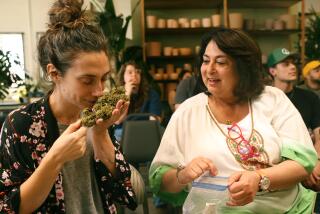Camomile plants: from pretty flowers to homegrown tea
- Share via
In summer, when the camomile is in full bloom and harvesting has begun, the gardeners at Stanford Avalon Community Garden in South L.A. let a portion of the field go to seed, ensuring a harvest down the line.
Most of the gardeners here are from Mexico, where té de manzanilla (camomile tea) is about as common as Coke on restaurant menus. In Europe, where camomile originated, the apple-scented flowers go back to the Middle Ages. It is the European ginseng, say some, extensively researched and included in the pharmacological record.
Even people who don’t believe in herbal remedies often will turn to camomile tea as a natural healer for an upset stomach or insomnia.
Two types are most common in gardens: Roman and German. German camomile (Matricaria chamomilla or Matricaria recutita) is an annual; Roman is a perennial. German gets to about 2 feet high, whereas Roman is a ground cover. Both can be used for tea, but German is more commonly used.
The fragrant blossoms of camomile resemble a daisy. Believers use it as an herbal blood thinner, antispasmodic, antiviral or anti-inflammatory. The complex essential oil released from the dried flower heads is an ingredient in skin lotions, shampoos, even hemorrhoid creams.
But camomile’s most common use is in tea: two teaspoons of dried flowers per cup of boiled water, steeped covered for 15 minutes, then pressed to get out every drop. Pregnant women are cautioned against drinking it lest it cause uterine contractions, and people with allergies also take caution because camomile is a relative of ragweed.
Even so, camomile is popular in the garden. It’s attractive to the predators that feed on aphids, and the plant is one of the top companions for edibles, growing well in the understory if it gets some full sun for part of the day. Camomile improves the flavor of its neighbors, especially cabbage, cucumbers and onions. Some gardeners use cold camomile tea as an anti-fungal spray to fight powdery mildew.
Seedlings will be available in October, once the weather cools, at specialty retailers such as Tabuchi Nursery in West L.A. But seeds are easy to find any time, online or at garden stores.
Scatter the tiny seeds onto prepared ground but be careful. Soil that is too organically rich will give you lots of leaves but fewer flowers. The seeds need light to germinate, so don’t cover them with more than a dusting of top soil. Wait a week or two for sprouts to appear and blooms will come two months later.
The Global Garden, our look at multicultural Los Angeles through the lens of its landscapes, appears here on Tuesdays.
ALSO:
Growing Santa Rita prickly pear
Growing abundant Jerusalem artichokes
Growing the tequila plant, Agave tequilana
JOIN THE CONVERSATION:@latimeshome | pinterest.com/latimeshome | facebook.com/latimeshome | facebook.com/latimesgarden






